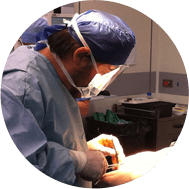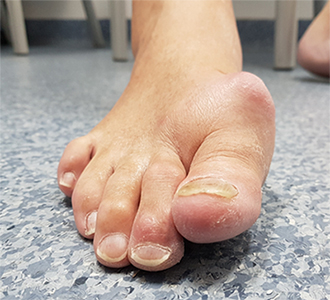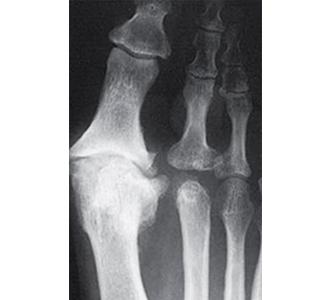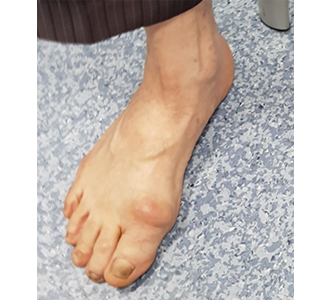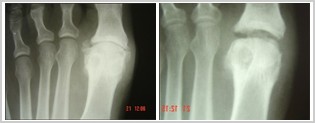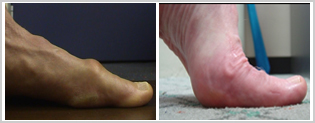Big Toe Joint Pain
Hallux rigidus is an arthritic condition characterized by stiffness and rigidity of the big toe. Arthritis of the foot commonly occurs at the big toe base. The condition can be quite painful as the big toe has to bend with every step you take.
The condition may occur due to age related wear and tear or an injury sustained at the joint between the big toe and the foot (metatarsophalangeal joint). This can lead to loss of the cartilage from the joint which provides a cushioning effect and allows smooth movement and flexibility of the big toe. The bones may rub against each other causing pain and the development of bone spurs that further restrict toe movement. Hence, the toe becomes stiff and walking is painful. Hallux rigidus usually occurs between 30 and 60 years of age. It may be more common with certain types of foot anatomy which place more stress on the big toe joint.
Pain is present at the base of the first toe especially when pushing off as you walk. It may be associated with swelling around the joint, a bony bump on the top portion of the foot as well as rigidity and inability to bend the toe.
If you find that your toe is painful and stiff causing you to bear weight on the outside of your foot, you might be suffering from hallux rigidus. It is recommended that you get it evaluated during the initial stages of the disease before any bone spurs develop.
Your doctor will discuss the symptoms in detail and perform a physical examination to accurately diagnose the extent and stage of your condition. X-rays will be ordered to look for any bone changes and loss of joint space that may have occurred.
Nonsurgical treatment in the form of pain-relieving medication and anti-inflammatories will be prescribed to reduce pain and swelling. Application of ice packs and contrast baths (alternating hot and cold-water soaks) may further ease your symptoms. Changing your shoe to one with a broader toe area and a stiff or rocker-bottom sole may help reduce pressure on the toe.
If these non-surgical treatment modalities do not provide relief, then your doctor will discuss the surgical options which may include:
- Arthroplasty: Replacement of the metatarsophalangeal joint with either an artificial one or one made from the body's own tissue. It is recommended for mild to moderate cases of hallux rigidus and preserves more joint movement than an arthrodesis.
- Arthrodesis: Fusing the toe to the foot. It is usually recommended if the cartilage is severely eroded and movement of the toe is very painful.
- Cheilectomy: Removal of bone spurs as well as a small portion of the bone from the foot to allow more toe movement. It is usually recommended in mild forms of the disease.
Modified Capsular Interpositional Arthroplasty Technique
Dr Ozcan has been pioneering a modified version of the capsular interpositional arthroplasty technique. This technique involves a combination of arthroplasty and cheilectomy with a tissue graft harvested from the patient's own body. It is done as a day case under general anaesthesia and the patient gains immediate function after the surgery. The patient is capable of immediate weight-bearing in surgical sandals for 3 weeks, followed by a further 3 weeks in sport shoes. This technique has been highly successful instead of the arthrodesis, and patients are back to their own choice of foot wear without any limitations.
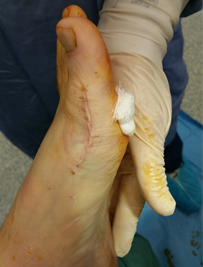
Modified capsular interpositional arthroplasty surgery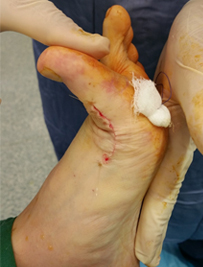
Modified capsular interpositional arthroplasty surgery
Fused joints: There are times when patients have had joint arthrodeses (fusions) at the big toe joint and now may be suffering from the ill effects of this procedure. The ill effects involve joint degeneration and deformation at the nearby joints, poor gait function and pain all over the foot. Dr Ozcan uses the modified capsular arthroplasty technique to reverse the arthrodesis (fusion) at these joints. He basically unfuses a fused joint without the use of any pins, screws or plates.





